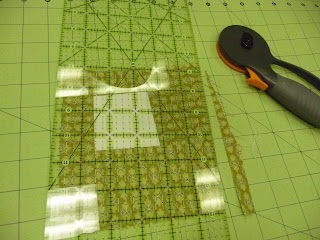For the last tutorial, we talked through the basting process, remember? Basting is securing all three layers of the quilt together - the quilt top, the batting, and the backing - prior to quilting. You have basting options - straight pins, curved quilting safety pins, or adhesive basting spray - and your choice just depends on your personal preference and style. I started out using the basting spray, and LOVED it because it kept all the layers very secure while quilting. I started moving away from using it because I couldn't afford it for all the projects I was doing. But, whatevs. It's your preference - try all three and see which you prefer.
Check out Caitlin's quilt, all basted and ready to go (she used basting spray):
Alright. This tutorial is about quilting. You're probably thinking, "Isn't that what we've been doing all along? Doesn't quilting mean 'to make a quilt'?" Well, yes. But it also means to sew through all three layers (top, batting, back) so they stay together. A lot of traditional quilting is done by hand. If you have the patience for that, kudos to you. I do NOT have the ability to do that kind of thing by hand, so I always machine-quilt my pieces. Side note: I typically use a regular 1/4" presser foot for quilting straight lines. I have used a walking foot too, but really I don't see any difference in the quality of the quilting. There's lots of
Basically, you'll take your 3-layer basted quilt, and feed it through the machine, stitching in a pattern of some sort over the entire quilt. There are a variety of pattern options out there. Caitlin chose "stitch in the ditch," which means she sewed straight lines in each of the seams. It doesn't really stand out on the front (because it's in the ditch, silly), but it shows up on the back. I think that is a fun choice for a wonky log cabin quilt, because it adds some wonkiness to the back of the quilt too. Just make sure you backstitch at the beginning and end of each seam - you don't want your masterpiece to unravel.
Others have decided on straight lines in a grid pattern - shows up more on the front and makes the quilt look "quilty" from both sides. I'm a sucker for a soft, awesome quilty-quilt. The more lines you stitch, the more quilty it'll look.
You have tons of options - sewing a line down the middle of each strip, quilting a diamond or triangle grid pattern, only quilting the middle strips or outer strips, quilting 1/4" off the seam lines ... and on and on. If you're not sure what to do, look around at what other people do, find quilts you like in magazines or on blogs, or allow the shape and pattern of the quilt to guide you. It's fun to come up with new patterns, but it's good to know that you can just do a grid too.
Another side note: if you want to branch out beyond straight lines, and if you feel comfortable with your machine, you might want to try free-motion quilting. Free-motion quilting gives you more control over the pattern, and you can do loops, circles, meandering patterns, or words. I won't give you the tutorial on that (because it overwhelms me), but there are lots of good ones on other blogs (like this one or this one). I will say, however, that you need to feel pretty comfortable with sewing and your machine before tackling a big quilt with free-motion. Maybe try it out on a few potholders first.
Quilt the entire quilt - some readjustment may be necessary in the basting as you go along, but that's to be expected.
Come back soon for Wonky Log Cabin Tutorial #6 ... the final step!























